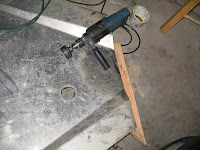 Ice axes are meant for just that: ice. However that is not what always covers the ground in the winter. Often times the slope or chute you are climbing is covered with hard snow, or neve. This is especially true if you are looking to ski down the same slope you just climbed up. Such conditions are difficult for a standard ice axe to gain a good purchase. The relatively thin blade of an ice axe cuts through the snow like a knife. A cold dull knife blade, but a knife never the less. Because of this fact the tube pick was invented. Rather than the standard ice axe blade, the pick of a "snow" axe has a semi circle cross section. This half moon shape has a much greater cross sectional area to hold the snow.
Ice axes are meant for just that: ice. However that is not what always covers the ground in the winter. Often times the slope or chute you are climbing is covered with hard snow, or neve. This is especially true if you are looking to ski down the same slope you just climbed up. Such conditions are difficult for a standard ice axe to gain a good purchase. The relatively thin blade of an ice axe cuts through the snow like a knife. A cold dull knife blade, but a knife never the less. Because of this fact the tube pick was invented. Rather than the standard ice axe blade, the pick of a "snow" axe has a semi circle cross section. This half moon shape has a much greater cross sectional area to hold the snow.I recently came across this particular axe: the Lowe Humming bird. This is a very versatile axe and can be configured for many conditions. The configuration which I received the axe in is quite unique. It purpose: to climb snow. Not only does it have a tube pick on one end, but a extra large tube pick for an adzes. This is something I have never seen before, and I have seen my share of ice climbing tools. The axe appears to be a hammer only axe, without the option of switching to an adzes. An adzes is flat blade used to chop steps in the ice. Ice axes are often constructed so that both the pick and the hammer can be removed and replaced with another type of pick or an adzes. If this option is not present, most likely there is another version of the axe with a forged adzes.
It then begs the question, is this an adzes attachment or an extra large tube pick attached to the axe's hammer. I would imagine that it is in fact an extra large tube pick for the following reasons. The full circle design of the piece in question would hold the snow in place. If it was intended to be a chopping tool it should be destined to be self clearing. Sure a second "chop" would drive out the snow lodged in by the first bite. However this is a small amount of snow taken with each bite. No very efficient for making steps. Next the short shaft design is intended for vertical or steep travel. In the steeps, crampons are a necessity and thus negates the need for steps. Finally chopping steps is an old mountaineering technical. One would chop steps if they are not wearing crampons, on low angle and/or if they are marking trail for others to follow. If any of those conditions were true one would be using a longer mountaineering axe rather than a short climbing tool.
If you ever find yourself out on a steep snow field, and your ice axe isn't cutting it, or it is in fact cutting through the snow; know that there are specific built ice tools for climbing the NEVE!








 So with this most recent oil change, I dropped the skid plate, changed the oil and filter, and before I reinstalled the plate I drilled a couple of access holes. The following is my account:
So with this most recent oil change, I dropped the skid plate, changed the oil and filter, and before I reinstalled the plate I drilled a couple of access holes. The following is my account:




